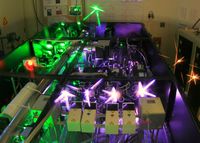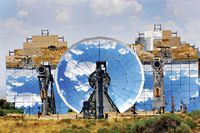Two new records have been set in fields that are related to either a real Space Elevator or the Space Elevator Games.
 Lasers are now the power source of choice (and perhaps necessity) for the next and succeeding Space Elevator Games Climber/Power-Beaming event. Researchers at the University of Michigan believe they have set a new record for laser intensity. It is described thusly:
Lasers are now the power source of choice (and perhaps necessity) for the next and succeeding Space Elevator Games Climber/Power-Beaming event. Researchers at the University of Michigan believe they have set a new record for laser intensity. It is described thusly:
“If you could hold a giant magnifying glass in space and focus all the sunlight shining toward Earth onto one grain of sand, that concentrated ray would approach the intensity of a new laser beam made in a University of Michigan laboratory.”
While I’m sure that this breakthrough does not have an immediate impact on either competitors in the Climber/Power-Beaming event at the Space Elevator Games or a real Space Elevator, it’s just another indication about how research in this field is ongoing.
 And, some previous entrants in the Climber/Power-Beaming event have attempted to use a Stirling Engine to propel their climber. A new record has been set in this field also:
And, some previous entrants in the Climber/Power-Beaming event have attempted to use a Stirling Engine to propel their climber. A new record has been set in this field also:
“Sandia National Laboratories and Stirling Energy Systems (SES) have set a new solar-to-grid system conversion efficiency record by achieving a 31.25 percent net efficiency rate. The old 1984 record of 29.4 percent was toppled Jan. 31 on SES’s “Serial #3″ solar dish Stirling system at Sandia’s National Solar Thermal Test Facility.”
Perhaps this development may help encourage another attempt with a Stirling-Engine powered climber.
(The laser picture was taken by Anatoly Maksimchuk and the Stirling dish picture was taken by Randy Montoya – they were from their respective stories. Click on them for a larger version. If someone showed up at the Games with a mirror like the one shown from Sandia, it would finally blow away what the KC Space Pirates had used. And, doesn’t the laser picture remind you of the laser focusing setup used by LaserMotive?)

I cannot understand why the climber has to be powered by a laser. Why not simply use bigger collectors facing the sun, or send the power up thru the ribbon (which will have metallic conductivity anyway if made of nanotubes of the right diameters). The ribbon might accidentally be hit by the laser and broken.
Could someone explain please? Thanks.
Why not simply use bigger collectors facing the sun,
You’d need acres of arrays to power a reasonably sized vehicle.
or send the power up thru the ribbon
This would work or a short distance – but not for the length needed to get to space.
There are some good reasons why beaming the power makes sense;
Remove the motor from the vehicle and you bring the cost per down.
Dispersed power beaming stations can be sited where energy and other costs are cheap, Consider the costs of running a gang of lasers on a mountain top in Peru versus the Mojave.
All of this makes sense now – the assumptions might change as time goes on.